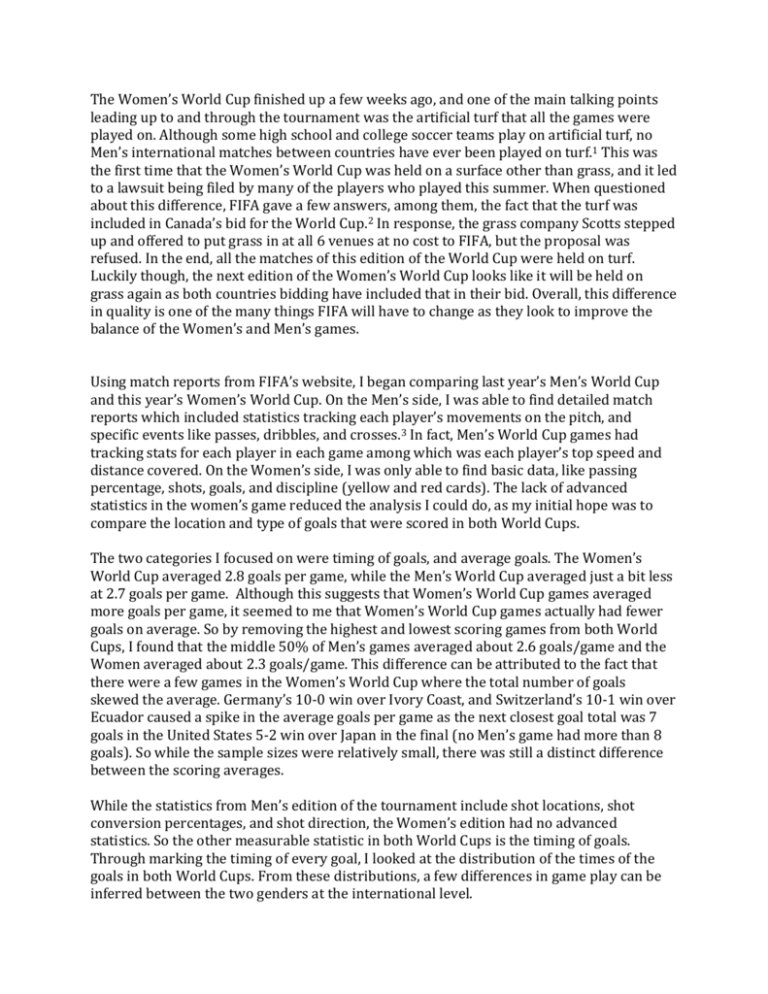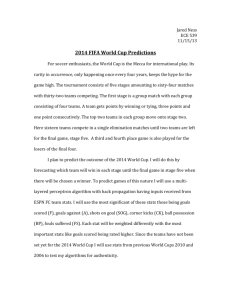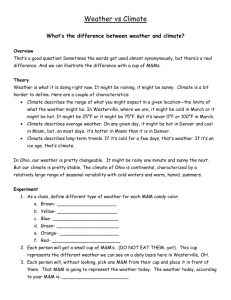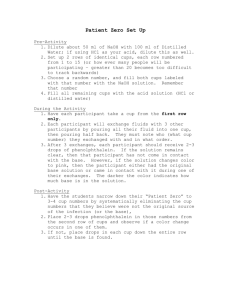File - Wash U Sports Analytics
advertisement

The Women’s World Cup finished up a few weeks ago, and one of the main talking points leading up to and through the tournament was the artificial turf that all the games were played on. Although some high school and college soccer teams play on artificial turf, no Men’s international matches between countries have ever been played on turf.1 This was the first time that the Women’s World Cup was held on a surface other than grass, and it led to a lawsuit being filed by many of the players who played this summer. When questioned about this difference, FIFA gave a few answers, among them, the fact that the turf was included in Canada’s bid for the World Cup.2 In response, the grass company Scotts stepped up and offered to put grass in at all 6 venues at no cost to FIFA, but the proposal was refused. In the end, all the matches of this edition of the World Cup were held on turf. Luckily though, the next edition of the Women’s World Cup looks like it will be held on grass again as both countries bidding have included that in their bid. Overall, this difference in quality is one of the many things FIFA will have to change as they look to improve the balance of the Women’s and Men’s games. Using match reports from FIFA’s website, I began comparing last year’s Men’s World Cup and this year’s Women’s World Cup. On the Men’s side, I was able to find detailed match reports which included statistics tracking each player’s movements on the pitch, and specific events like passes, dribbles, and crosses.3 In fact, Men’s World Cup games had tracking stats for each player in each game among which was each player’s top speed and distance covered. On the Women’s side, I was only able to find basic data, like passing percentage, shots, goals, and discipline (yellow and red cards). The lack of advanced statistics in the women’s game reduced the analysis I could do, as my initial hope was to compare the location and type of goals that were scored in both World Cups. The two categories I focused on were timing of goals, and average goals. The Women’s World Cup averaged 2.8 goals per game, while the Men’s World Cup averaged just a bit less at 2.7 goals per game. Although this suggests that Women’s World Cup games averaged more goals per game, it seemed to me that Women’s World Cup games actually had fewer goals on average. So by removing the highest and lowest scoring games from both World Cups, I found that the middle 50% of Men’s games averaged about 2.6 goals/game and the Women averaged about 2.3 goals/game. This difference can be attributed to the fact that there were a few games in the Women’s World Cup where the total number of goals skewed the average. Germany’s 10-0 win over Ivory Coast, and Switzerland’s 10-1 win over Ecuador caused a spike in the average goals per game as the next closest goal total was 7 goals in the United States 5-2 win over Japan in the final (no Men’s game had more than 8 goals). So while the sample sizes were relatively small, there was still a distinct difference between the scoring averages. While the statistics from Men’s edition of the tournament include shot locations, shot conversion percentages, and shot direction, the Women’s edition had no advanced statistics. So the other measurable statistic in both World Cups is the timing of goals. Through marking the timing of every goal, I looked at the distribution of the times of the goals in both World Cups. From these distributions, a few differences in game play can be inferred between the two genders at the international level. Women Min breakdown 1--5 6--10 11--15 16--20 21--25 26--30 31-35 36-40 41-45 46-50 51-55 56-60 61-65 66-70 71-75 76-80 81-85 86-90 Men 8 7 12 4 7 10 8 6 5 45+ 5 10 5 10 5 8 10 8 7 90+ 1--45 46--90 9169 120+ 76 2 8 1 Min breakdown 1--5 6--10 11--15 16--20 21--25 26--30 31--35 36--40 41--45 46--50 51--55 56--60 61--65 66--70 71--75 76--80 81--85 86--90 7 4 7 9 7 9 9 5 5 45+ 10 8 6 10 9 14 9 13 7 90+ 1--45 46--90 9165 120+ 98 3 12 8 Even though the Women played 12 fewer games than the Men, Women’s goals in the first half actually exceeded the Men’s total of first half goals. During the first half, the height of those goals happened between minutes 11-15 and 26-30 for the Women. Overall, the scoring during the Women’s World Cup was fairly balanced between the first half and the second half, with 47.6% of goals coming in the first half. On the Men’s side, however, the vast majority of goals were scored in the second half of games, with just over 60% of goals being scored in the second 45 minutes of the game(excluding extra time). This seems to suggest that one of the main differences between the Men’s game and Women’s game is that Men’s teams scored more often when the teams started to tire in the second half when fresh substitutes were brought on. Whereas on the Women’s side, goals seemed to be consistent from half to half and suggest that substitutes and tiredness don’t contribute as much to scoring in the Women’s game. This may seem counter-intuitive as some pundits credited the US Women’s National Team’s success to better fitness when they would tire their opponents out before scoring a winning goal late in the game. Through looking at extra time goals (30 minutes played when tied after full time in knockout stages), we can see that this trend continues. While the Women’s World Cup only had two games that went into extra time, the Men’s World Cup had eight. During their two extra time games, the Women only scored one goal during those extra 60 minutes, whereas on the Men’s side, 8 goals were scored. In fact, of those eight games, all of the goals occurred after the score was tied at zero after 90 minutes (which happened in 6 of the 8 games). Overall, I think the knockout stages and the finals of both tournaments are representative of overall trends between the genders at the International stage. The Men’s final was a low scoring affair that ended 1-0 after extra time, whereas the Women’s final was a high scoring affair at 5-2, and showed a clear difference in quality between the two teams that were in the final. As the Women’s game continues to develop and improve around the world, I think that the tournament will expand to match the 32 teams that the Men have. Initially, I believe that the scoring trends of the next expansion to 32 teams will be very similar to the trends this year as expanding the field will surely lead to a larger gap in skill levels between the top nations and the new entrants in the competition. Eventually though, I believe that the scoring trends of the Women’s game will approach where the Men’s game was this year, as fitness levels increase and the margins between teams decrease. 1.http://ftw.usatoday.com/2015/05/fifa-rejected-offers-grass-companies-turfcontroversy 2. https://www.washingtonpost.com/news/soccer-insider/wp/2015/01/16/artificialturf-to-remain-for-womens-world-cup/ 3.fifa.com









